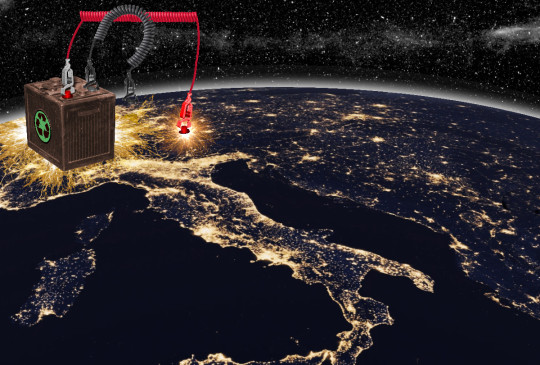#Mountain Environment
Explore tagged Tumblr posts
Text
Between Refuge and Risk: The Avalanche Paradox for Mountain Ungulates
ESP version ITA version In the changing context of mountain environments, climate change manifests with rapid and significant transformations, profoundly influencing sensitive communities and ecological processes. A crucial element in this landscape is represented by the seasonal conditions of snow, which prove to be determinants for the dynamics of mountain ungulate populations. These variations directly affect vital ecological and physiological aspects, such as the energy costs of locomotion, vulnerability to predation, and the availability and quality of forage, both in summer and winter.
A recent study published in Nature explored how mountain goats, adapted to steep terrains to evade predators, paradoxically find themselves at risk due to the frequent instability of these slopes, which can generate avalanches. The research, conducted in southeastern Alaska on 421 goats monitored for 17 years, highlights that avalanches cause between 23% to 65% of annual deaths, primarily affecting the young and small. These steep areas, chosen to mitigate the risk of predation, turn out to be ecological traps due to their high risk of avalanches. This risk is variable, with peaks during the most unstable months for snow, especially at the beginning of winter and during the spring thaw.
The migratory and wintering strategies of ungulates further influence their exposure to the risk of avalanches. For example, mountain goats in Lynn Canal are extremely migratory, moving to low-altitude forested habitats during the winter, while other populations remain at higher altitudes, exposing themselves more to danger.
Climate change exacerbates this dynamic, modifying the frequency and intensity of avalanches, and consequently, the spatial and temporal distribution of these lethal events. Forecasts indicate an increase in wet avalanches compared to those of dry snow, with a potential increase in avalanche mortality rates.
The persistence of this risk in mountain systems, combined with the anticipated rise in the snowline elevation, may reduce the avalanche danger at lower altitudes, but the risk will continue to be a significant component in the ecology of mountain ungulates. However, the demographic influence of avalanches on ungulate populations is likely to persist in the future because both the avalanche danger and the ranges of mountain ungulates are expected to shift upward as the climate warms.
It is essential to emphasize that the growth rates of mountain goat populations are particularly low and can only sustain limited annual removals. Therefore, avalanche mortality, especially among young individuals, can have severe demographic impacts, leading to population decline. These data highlight the need to reconsider conservation and management strategies for these vulnerable populations.
The intensification of climate change and its extreme manifestations, such as avalanches, necessitates a rethinking of conservation policies to protect not only mountain ungulates but also the ecological integrity of mountain environments, which are crucial for global biodiversity.
Source: https://www.nature.com/articles/s42003-024-06073-0
Credits picture: NPS/Diane Renkin

#Climate Change#Avalanches#Mountain Goat#Goat#Mountain Environment#Mountain#Snow#Conservation#Ecology#Animals#Ungulates#Drops Of Science#Science#News#Updates#Latest News#Nature#Biodiversity#Biodiversity Loss
4 notes
·
View notes
Text

Midnight is so bright in here
#spyro#spyro the dragon#spyro reignited trilogy#art study#environment art#midnight mountain#art#frong art
617 notes
·
View notes
Text
#NorthernRaven
Early morning visit from a friend… maybe too early. Mountainous Parts of the Northern Hemisphere.
@BenAdrienProulx December 12, 2024.
#Northern Raven#Ravens#Wildlife Need Protection#Wilderness Need Protection#IUCN#International Union for Conservation of Nature#ECCC#Environment and Climate Change Canada#FeederWatch#Count Feeder Birds for Science#NCC#Nature Conservancy of Canada#Silent Hill#Raw Nature#Nature Photography#Nature Canada#Wild Bird Photography#Wildlife Photography#Bird#Bird Photography#Animal Photography#Animal Video#The Heart of the Healer#Mountainous Parts of the Northern Hemisphere#Canada#Mohawk Native Reserve#The RavenKeeper
488 notes
·
View notes
Text

apuseni natural park in autumn. morning landscape of varasoaia meadow, bihor, romania. forest on the mountain in fall color. spruce trees in the valley. sunny weather
#mountain#autumn#forest#landscape#fall#park#romania#nature#apuseni#scenery#natural#sunny#tree#morning#color#meadow#valley#weather#spruce#varasoaia#bihor county#picturesque#carpathian#environment#beautiful#foliage#woodland#outdoor#hill#location
558 notes
·
View notes
Text

Every time I think about the Tree of Feelings I can't help but be a little underwhelmed at how the most popular depictions of it is just. the tree. on a hill. surrounded by miles of nothing but grass and maybe a few houses in the distance.
Yeah, no thanks. I'll just go with my own interpretation on this one
#dreamtale#utmv#undertale au#dryeart#my art#fanart#not that it's bad#but for a sacred tree that needs constant protection...#that damn tree can be spotted from miles away#with no natural barriers#like. come on.#something like a forest or valley would make so much more sense. hell even a mountain would work better#and idk maybe even have a magical forest surrounding and also acting as a barrier for the important magical tree#instead of just. relying solely on a couple of prepubescent children#dream sans#nightmare sans#they're the little silhouettes under the tree it fucking counts#digital art#digital painting#environment art#concept art
2K notes
·
View notes
Text

:)
328 notes
·
View notes
Text
Circular battery self-sufficiency

I'm coming to DEFCON! On FRIDAY (Aug 9), I'm emceeing the EFF POKER TOURNAMENT (noon at the Horseshoe Poker Room), and appearing on the BRICKED AND ABANDONED panel (5PM, LVCC - L1 - HW1–11–01). On SATURDAY (Aug 10), I'm giving a keynote called "DISENSHITTIFY OR DIE! How hackers can seize the means of computation and build a new, good internet that is hardened against our asshole bosses' insatiable horniness for enshittification" (noon, LVCC - L1 - HW1–11–01).

If we are going to survive the climate emergency, we will have to electrify – that is, transition from burning fossil fuels to collecting, storing, transmitting and using renewable energy generated by e.g. the tides, the wind, and (especially) the Sun.
Electrification is a big project, but it's not an insurmountable one. Planning and executing an electric future is like eating the elephant: we do it one step at a time. This is characteristic of big engineering projects, which explains why so many people find it hard to imagine pulling this off.
As a layperson, you are far more likely to be exposed to a work of popular science than you are a work of popular engineering. Pop science is great, but its role is to familiarize you with theory, not practice. Popular engineering is a minuscule and obscure genre, which is a pity, because it's one of my favorites.
Weathering the climate emergency is going to require a lot of politics, to be sure, but it's also going to require a lot of engineering, which is why I'm grateful for the nascent but vital (and growing) field of popular engineering. Not to mention, the practitioners of popular engineering tend to be a lot of fun, like the hosts of the Well That's Your Problem podcast, a superb long-form leftist podcast about engineering disasters (with slides!):
https://www.youtube.com/@welltheresyourproblempodca1465
If you want to get started on popular engineering and the climate, your first stop should be the "Without the Hot Air" series, which tackles sustainable energy, materials, transportation and food as engineering problems. You'll never think about climate the same way again:
https://pluralistic.net/2021/01/06/methane-diet/#3kg-per-day
Then there's Saul Griffith's 2021 book Electrify, which is basically a roadmap for carrying out the electrification of America and the world:
https://pluralistic.net/2021/12/09/practical-visionary/#popular-engineering
Griffith's book is inspiring and visionary, but to really get a sense of how fantastic an electrified world can be, it's gotta be Deb Chachra's How Infrastructure Works:
https://pluralistic.net/2023/10/17/care-work/#charismatic-megaprojects
Chachra is a material scientist who teaches at Olin College, and her book is a hymn to the historical and philosophical underpinnings of infrastructure, but more than anything, it's a popular engineering book about what is possible. For example, if we want to give every person on Earth the energy budget of a Canadian (like an American, but colder), we would only have to capture 0.4% of the solar energy that reaches the Earth's surface.
Now, this is a gigantic task, but it's a tractable one. Resolving it will require a very careful – and massive – marshaling of materials, particularly copper, but also a large number of conflict minerals and rare earths. It's gonna be hard.
But it's not impossible, let alone inconceivable. Indeed, Chachra's biggest contribution in this book is to make a compelling case for reconceiving our relationship to energy and materials. As a species, we have always treated energy as scarce, trying to wring every erg and therm that we can out of our energy sources. Meanwhile, we've treated materials as abundant, digging them up or chopping them down, using them briefly, then tossing them on a midden or burying them in a pit.
Chachra argues that this is precisely backwards. Our planet gets a fresh supply of energy twice a day, with sunrise (solar) and moonrise (tides). On the other hand, we've only got one Earth's worth of materials, supplemented very sporadically when a meteor survives entry into our atmosphere. Mining asteroids, the Moon and other planets is a losing proposition for the long foreseeable future:
https://pluralistic.net/2024/01/09/astrobezzle/#send-robots-instead
The promise of marshaling a very large amount of materials is that it will deliver effectively limitless, clean energy. This project will take a lot of time and its benefits will primarily accrue to people who come after its builders, which is why it is infrastructure. As Chachra says, infrastructure is inherently altruistic, a gift to our neighbors and our descendants. If all you want is a place to stick your own poop, you don't need to build a citywide sanitation system.
What's more, we can trade energy for materials. Manufacturing goods so that they gracefully decompose back into the material stream at the end of their lives is energy intensive. Harvesting materials from badly designed goods is also energy intensive. But if once we build out the renewables grid (which will take a lot of materials), we will have all the energy we need (to preserve and re-use our materials).
Our species' historical approach to materials is not (ahem) carved in stone. It is contingent. It has changed. It can change again. It needs to change, because the way we extract materials today is both unjust and unsustainable.
The horrific nature of material extraction under capitalism – and its geopolitics (e.g. "We will coup whoever we want! Deal with it.") – has many made comrades in the climate fight skeptical (or worse, cynical) about a clean energy transition. They do the back-of-the-envelope math about the material budget for electrification, mentally convert that to the number of wildlife preserves, low-income communities, unspoiled habitat and indigenous lands that we would destroy in the process of gathering those materials, and conclude that the whole thing is a farce.
That analysis is important, but it's incomplete. Yes, marshaling all those materials in the way that we do today would be catastrophic. But the point of a climate transition is that we will transition our approach to our planet, our energy, and our materials. That transition can and should challenge all the assumptions underpinning electrification doomerism.
Take the material bill itself: the assumption that a transition will require a linearly scaled quantity of materials includes the assumption that cleantech won't find substantial efficiencies in its material usage. Thankfully, that's a very bad assumption! Cleantech is just getting started. It's at the stage where we're still uncovering massive improvements to production (unlike fossil fuel technology, whose available efficiencies have been discovered and exploited, so that progress is glacial and negligible).
Take copper: electrification requires a lot of copper. But the amount of copper needed for each part of the cleantech revolution is declining faster than the demand for cleantech is rising. Just one example: between the first and second iteration of the Rivian electric vehicle, designers figured out how to remove 1.6 miles of copper wire from each vehicle:
https://insideevs.com/news/722265/rivian-r1s-r1t-wiring/
That's just one iteration and one technology! And yeah, EVs are only peripheral to a cleantech transition; for one thing, geometry hates cars. We're going to have to build a lot of mass transit, and we're going to be realizing these efficiencies with every generation of train, bus, and tram:
https://pluralistic.net/2024/02/29/geometry-hates-uber/#toronto-the-gullible
We have just lived through a massive surge in electrification, with unimaginable quantities of new renewables coming online and a stunning replacement of conventional vehicles with EVs, and throughout that surge, demand for copper remained flat:
https://www.chemanalyst.com/NewsAndDeals/NewsDetails/copper-wire-price-remains-stable-amidst-surplus-supply-and-expanding-mining-25416#:~:text=Global%20Copper%20wire%20Price%20Remains%20Stable%20Amidst%20Surplus%20Supply%20and%20Expanding%20Mining%20Activities
This isn't to say that cleantech is a solved problem. There are many political aspects to cleantech that remain pernicious, like the fact that so many of the cleantech offerings on the market are built around extractive financial arrangements (like lease-back rooftop solar) and "smart" appliances (like heat pumps and induction tops) that require enshittification-ready apps:
https://pluralistic.net/2024/06/26/unplanned-obsolescence/#better-micetraps
There's a quiet struggle going on between cleantech efficiencies and the finance sector's predation, from lease-back to apps to the carbon-credit scam, but many of those conflicts are cashing out in favor of a sustainable future and it doesn't help our cause to ignore those: we should be cheering them on!
https://pluralistic.net/2024/06/12/s-curve/#anything-that-cant-go-on-forever-eventually-stops
Take "innovation." Silicon Valley's string of pump-and-dump nonsense – cryptocurrency, NFTs, metaverse, web3, and now AI – have made "innovation" into a dirty word. As the AI bubble bursts, the very idea of innovation is turning into a punchline:
https://www.wheresyoured.at/burst-damage/
But cleantech is excitingly, wonderfully innovative. The contrast between the fake innovation of Silicon Valley and the real – and vital – innovation of cleantech couldn't be starker, or more inspiring:
https://pluralistic.net/2024/05/30/posiwid/#social-cost-of-carbon
Like the "battery problem." Whenever the renewables future is raised, there's always a doomer insisting that batteries are an unsolved – and unsolvable – problem, and without massive batteries, there's no sense in trying, because the public won't accept brownouts when the sun goes down and the wind stops blowing.
Sometimes, these people are shilling boondoggles like nuclear power (reminder: this is Hiroshima Day):
https://theconversation.com/dutton-wants-australia-to-join-the-nuclear-renaissance-but-this-dream-has-failed-before-209584
Other times, they're just trying to foreclose on the conversation about a renewables transition altogether. But sometimes, these doubts are raised by comrades who really do want a transition and have serious questions about power storage.
If you're one of those people, I have some very good news: battery tech is taking off. Some of that takes the form of wild and cool new approaches. In Finland, a Scottish company is converting a disused copper mine into a gravity battery. During the day, excess renewables hoist a platform piled with tons of rock up a 530m shaft. At night, the platform lowers slowly, driving a turbine and releasing its potential energy. This is incredibly efficient, has a tiny (and sustainable) bill of materials, and it's highly replicable. The world has sufficient abandoned mine-shafts to store 70TWh of power – that's the daily energy budget for the entire planet. What's more, every mine shaft has a beefy connection to the power grid, because you can't run a mine without a lot of power:
https://www.euronews.com/green/2024/02/06/this-disused-mine-in-finland-is-being-turned-into-a-gravity-battery-to-store-renewable-ene
Gravity batteries are great for utility-scale storage, but we also need a lot of batteries for things that we can't keep plugged into the wall, like vehicles, personal electronics, etc. There's great news on that score, too! "The Battery Mineral Loop" is a new report from the Rocky Mountain Institute that describes the path to "circular battery self-sufficiency":
https://rmi.org/wp-content/uploads/dlm_uploads/2024/07/the_battery_mineral_loop_report_July.pdf
The big idea: rather than digging up new minerals to make batteries, we can recycle minerals from dead batteries to make new ones. Remember, energy can be traded for materials: we can expend more energy on designs that are optimized to decompose back into their component materials, or we can expend more energy extracting materials from designs that aren't optimized for recycling.
Both things are already happening. From the executive summary:
The chemistry of batteries is rapidly improving: over the past decade, we've reduced per-using demand for lithium, nickle and cobalt by 60-140%, and most lithium batteries are being recycled, not landfilled.
Within a decade, we'll hit peak mineral demand for batteries. By the mid-2030s, the amount of new "virgin minerals" needed to meet our battery demand will stop growing and start declining.
By 2050, we could attain net zero mineral demand for batteries: that is, we could meet all our energy storage needs without digging up any more minerals.
We are on a path to a "one-off" extraction effort. We can already build batteries that work for 10-15 years and whose materials can be recycled with 90-94% efficiency.
The total quantity of minerals we need to extract to permanently satisfy the world's energy storage needs is about 125m tons.
This last point is the one that caught my eye. Extracting 125m tons of anything is a tall order, and depending on how it's done, it could wreak a terrible toll on people and the places they live.
But one question I learned to ask from Tim Harford and BBC More Or Less is "is that a big number?" 125m tons sure feels like a large number, but it is one seventeenth of the amount of fossil fuels we dig up every year just for road transport. In other words, we're talking about spending the next thirty years carefully, sustainably, humanely extracting about 5.8% of the materials we currently pump and dig every year for our cars. Do that, and we satisfy our battery needs more-or-less forever.
This is a big engineering project. We've done those before. Crisscrossing the world with roads, supplying billions of fossil-fuel vehicles, building the infrastructure for refueling them, pumping billions of gallons of oil – all of that was done in living memory. As Robin Sloan wrote:
Did people say, at the dawn of the automobile: are you kidding me? This technology will require a ubiquitous network of refueling stations, one or two at every major intersection … even if there WAS that much gas in the world, how would you move it around at that scale? If everybody buys a car, you’ll need to build highways, HUGE ones — you’ll need to dig up cities! Madness!
https://www.robinsloan.com/newsletters/room-for-everybody/
That big project cost trillions and required bending the productive capacity of many nations to its completion. It produced a ghastly geopolitics that elevated petrostates – a hole in the ground, surrounded by guns – to kingmakers whose autocrats can knock the world on its ass at will.
By contrast, this giant engineering project is relatively modest, and it will upend that global order, yielding energy sovereignty (and its handmaiden, national resliency) to every country on Earth. Doing it well will be hard, and require that we rethink our relationship to energy and materials, but that's a bonus, not a cost. Changing how we use materials and energy will make all our lives better, it will improve the lives of the living things we share the planet with, and it will strip the monsters who currently control our energy supply of their political, economic, and electric power.

If you'd like an essay-formatted version of this post to read or share, here's a link to it on pluralistic.net, my surveillance-free, ad-free, tracker-free blog:
https://pluralistic.net/2024/08/06/with-great-power/#comes-great-responsibility
#pluralistic#debcha#solarpunk#energy#cleantech#bill mckibben#material science#promethean climate transition#rocky mountain institute#battery mineral loop#climate#environment#peak minerals
297 notes
·
View notes
Text
REPOSTOBER, day 4: some Skyrim vibes (2014)

I was learning to draw backgrounds and experimenting with different brushes in PS. It was a nice time.

#repostober#environment art#old art#well TECHNICALLY it's not even a repost#since I never posted these on Tumblr#so enjoy some fresh new art I guess#Mountains#Skyrim#high hrothgar#the elder scrolls
661 notes
·
View notes
Text


had some fun coloring an inktober sketch
113 notes
·
View notes
Text


varias escenas de monterrey (30 mins)
#the mountains are so nice#kokoart#daily#original#art#environment art#landscape#daily drawing#illustration#background#background art#mountain
99 notes
·
View notes
Text

#etherealarte#etherealuploads#on ig#world environment day#horse#horse riding#horseback riding#horselife#equestrian#equestrianism#equestrianlife#mountains#old money#luxury lifestyle#luxury#classy#nature#trees#landscape#nature photography#forest#travel photo blog#love#travel pics#travel photo diary#travelling#travel#travel photography#vacation#wanderlust
92 notes
·
View notes
Text
An Indigenous woman from the Inga community in the Condagua reservation in Putumayo, Colombia, is leading the struggle against a Canadian mining company that plans to mine the community’s sacred mountains for copper and molybdenum.
Within Soraida Chindoy’s territory is the Doña Juana-Chimayoy páramo, where eight rivers have their source and where there are 56 lagoons. The site, where the Amazon rainforest and the Andes meet, is sacred to the Indigenous population.
Her campaign against mining was borne of tragedy. In 2017, she and her family were among the almost 22,000 people affected by the landslide in Mocoa, when Mother Earth provided a stark warning as to why it is so important to take care of her.
#indigenous#indigenous women#columbia#canada#amazon#the amazon#andes mountains#sacred#land#environmentalism#environment
204 notes
·
View notes
Text

All of the Spyro hub world paintings. With reference screenshots below 💛

#spyro#spyro the dragon#spyro 3#ps1#psx#art#environment#art study#spyro year of the dragon#sunrise spring#midday gardens#evening lake#midnight mountain#frong art
417 notes
·
View notes
Text

#MurmursCreek
Mountainous Part of the Northern Hemisphere.
@BenAdrienProulx January 12, 2025.
#Murmurs Creek#Medicine Songs#The Heart of the Healer#Hundred Years Old Pine Forest#Sacred Land#Ouareau Forest#Undisturbed Environment#Wilderness Need Protection#IUCN#International Union for Conservation of Nature#ECCC#Environment and Climate Change Canada#NCC#Nature Conservancy of Canada#Raw Nature#Nature Photography#Nature Canada#Wildlife Photography#Bird Photography#Mountainous Parts of the Northern Hemisphere#Canada#Mohawk Native Reserve#The RavenKeeper
312 notes
·
View notes
Text

landscape with carpathian mountains, forest and a river in front. beautiful scenery in summer
#river#mountain#forest#stream#spring#water#summer#environment#green#outdoor#park#sky#valley#hill#blue#europe#season#tranquil#grass#stone#view#creek#cloud#scenery#tourism#sunny#scenic#splash#idyllic#nature
533 notes
·
View notes

